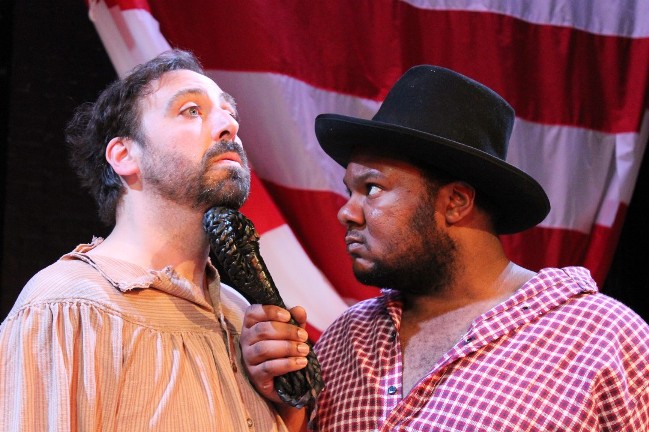
Uncle Tom’s Cabin: An Unfortunate History. Based on the novel by Harriet Beecher Stowe; Adapted by Lane Savadove and Glenn Odom. EgoPo Classic Theater June, 2013
*
Virtually everyone knows about Uncle Tom’s Cabin, the 1852 novel that mobilized American public opinion against slavery. Yet how many of our generation have read it?
Harriet Beecher Stowe’s book has acquired a reputation for being sentimental and melodramatic, but EgoPo’s production, on the other hand, emerged with surprisingly strong narrative force. Eliza fleeing across the ice is just one small scene among a plethora of incidents that build to a tragic climax. As adapted by Lane Savadove and Glenn Odom, Uncle Tom’s Cabin has an interweaving of characters who impact each other logically and with complexity.
The Stowe novel is widely perceived as a Christian tract. Tom and other black slaves find their solace in Christian love, and some of the play’s language presages Julia Ward Howe’s lyrics in “The Battle Hymn of the Republic” (“In the beauty of the lilies Christ was born… to transfigure you and me”). The dying Eva tells the slaves that they must become Christians so that they may see each other in Heaven.
So I was surprised to see and hear, in this production, a powerful condemnation of God and religion from a black character who was the mistress of the slave-owning Simon Legree. This version balances religious blacks with impious blacks, just as it countervails differing degrees of racism.
Many white people of the north (like Stowe herself) campaigned for an end to slavery, but EgoPo’s production reminds us that some of those abolitionists regarded the Negroes as inferior beings. It’s dismaying enough to hear Southern slave owners talk about blacks as “bales of merchandise” —- and even worse to hear Northerners compare blacks to animals.
Some of the slavery arguments in this Uncle Tom’s Cabin bear an eerie resemblance to today’s debates about immigration. If we free the slaves, who will educate them? And how will we train them for jobs in the North? And won’t they take jobs away from white people?
The story begins when a relatively benevolent white property owner decides he must sell off two of his slaves to pay his bills. One of those is Tom, a gentle man with a wife and children, but his owner can’t acknowledge the evil of separating a man from his family. By the end of this complex story we seem to have come full circle with Tom’s imminent liberation when the play reaches its tragic denouement.
Afterward I went home and re-read parts of the Stowe novel. This production, I subsequently concluded, packs more power than the original book. To actually see a slave auction and the whippings, beatings and shooting is more visceral than any words on paper. It’s one thing to read about slave whippings and auctions, another to actually watch them. Much of the play is downright painful to watch.
It would be absolutely unbearable if we had to watch white people whipping blacks. Instead, director Savadove has cast black actors in all the white roles and white actors as the black characters. The symbolism adds extra meaning to the theme. It forces whites and blacks in the audience to experience slavery as they’ve never experienced it before.
Among the outstanding actors in the 15-person cast are Langston Darby as a slave trader and as Simon Legree, and Ed Swidey as Uncle Tom. Also, Rachel O’Hanlon-Rodriguez as the slaves Harry and Topsy; Caroline Crocker as Uncle Tom’s wife, Chloe; Nia Ali as Little Eva; Maria Konstantinidis as Eliza; Lia Simon as Ophelia St. Clare; Katie Croyle as Dinah and Cassy, and more.
Natalia de la Torre deserves recognition for the resplendent antebellum costumes and Paule Turner for choreography.
For an added bonus, a pre-show tableau has all the cast assembled on stage, miming a slow-motion idealization of pre-Civil War plantation life: pitching horseshoes, fiddling, and eating while Stephen Foster songs and patriotic anthems play in the background. All gone with the wind, thank God.
Read more reviews on The Cultural Critic